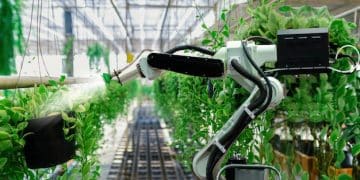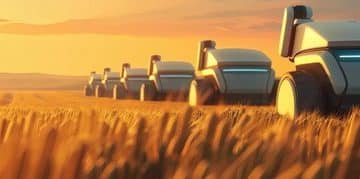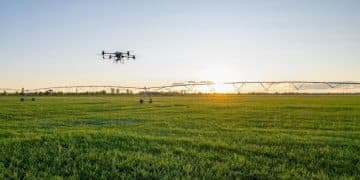Agricultural Drones: Regulations, Uses & ROI in the US
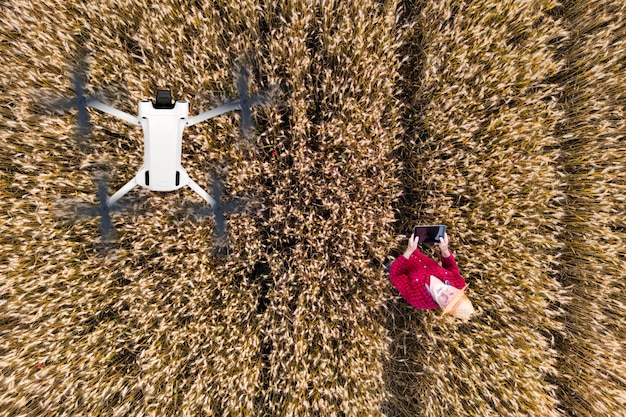
Agricultural drones are revolutionizing farming in the US by enhancing efficiency, precision, and sustainability through various applications, while navigating a complex regulatory landscape and offering a promising return on investment.
Agricultural drones: A Comprehensive Guide to Regulations, Applications, and ROI in the US are changing the face of farming. This guide explores their uses, benefits, regulations, and potential return on investment for US farmers.
Understanding Agricultural Drones in the US
Agricultural drones, also known as unmanned aerial vehicles (UAVs), are aircraft without a human pilot on board. They are remotely controlled or can fly autonomously through software-controlled flight plans. In agriculture, these drones are equipped with sensors, cameras, and sprayers to perform a variety of tasks.
The use of drones in agriculture has surged in recent years. This is mainly due to their ability to provide detailed insights and perform tasks more efficiently than traditional methods. From crop monitoring to precision spraying, agricultural drones are becoming indispensable tools for modern farmers in the US.
Benefits of Using Drones in Agriculture
Drones offer numerous advantages that contribute to more efficient and sustainable farming practices.
- Enhanced Crop Monitoring: Drones can quickly survey large fields and provide high-resolution images, identifying areas needing attention.
- Precision Spraying: They can apply pesticides, herbicides, and fertilizers with greater accuracy, reducing waste and environmental impact.
- Improved Irrigation Management: Drones equipped with thermal sensors can detect water stress in crops, optimizing irrigation schedules.
- Livestock Management: Drones can monitor livestock, track their movements, and ensure their well-being.
These benefits translate into cost savings, increased yields, and more sustainable farming practices, making drones an attractive investment for US farmers.
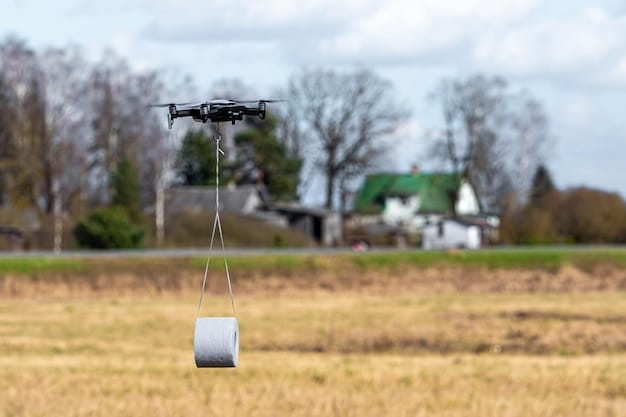
US Regulations for Agricultural Drone Use
Operating drones in the US for commercial purposes, including agriculture, is subject to regulations set by the Federal Aviation Administration (FAA). These regulations aim to ensure the safety of the national airspace and protect people and property on the ground.
Understanding and complying with these regulations is essential for any farmer looking to integrate drones into their operations. Key aspects include drone registration, pilot certification, and operational restrictions.
Key FAA Regulations for Agricultural Drones
Here are some of the critical FAA regulations that agricultural drone operators in the US must adhere to:
- Registration: All drones weighing between 0.55 pounds (250 grams) and 55 pounds must be registered with the FAA.
- Remote Pilot Certificate: Operators must obtain a Remote Pilot Certificate, which requires passing an FAA knowledge test.
- Operational Restrictions: Drones must be flown within visual line of sight (VLOS) and cannot be operated over people unless a waiver is obtained.
- Altitude Restrictions: Drones cannot be flown higher than 400 feet above ground level (AGL) unless operating near a structure.
Compliance with these regulations ensures that drone operations are conducted safely and legally, avoiding potential fines and penalties.
Applications of Drones in Agriculture
Agricultural drones have diverse applications that span the entire farming cycle, from planting to harvesting. Their ability to collect and analyze data quickly and accurately makes them valuable tools for optimizing various farming practices.
The applications range from simple visual inspections to complex data analysis, providing farmers with insights that were previously unattainable.
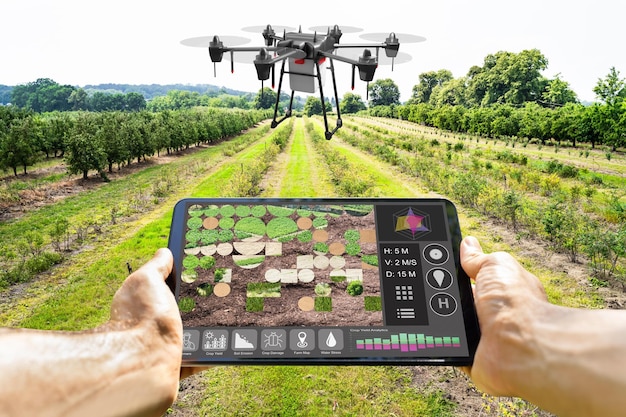
Specific Applications of Agricultural Drones
- Crop Health Assessment: Using multispectral and thermal cameras, drones can assess crop health, detect diseases, and identify nutrient deficiencies.
- Planting: Drones can be used to plant seeds, particularly in areas that are difficult to access or where traditional planting methods are inefficient.
- Spraying: Drones can precisely apply pesticides, herbicides, and fertilizers, reducing waste and minimizing environmental impact.
- Yield Monitoring: Drones can estimate crop yields by analyzing plant density, health, and other factors, helping farmers make informed decisions about harvesting.
By leveraging these applications, farmers can improve their operational efficiency, reduce costs, and increase yields, enhancing their profitability and sustainability.
Calculating ROI on Agricultural Drones
Investing in agricultural drones involves a significant upfront cost, but the potential return on investment (ROI) can be substantial. Calculating the ROI involves considering various factors, including the cost of the drone, maintenance, training, and the potential benefits in terms of increased yields, reduced costs, and improved efficiency.
Several factors determine if the investment is worthwhile. One needs to evaluate the unique operation and specific needs to evaluate if the benefits outweigh the costs.
Factors Affecting ROI on Agricultural Drones
Here are some of the key factors that influence the ROI on agricultural drones:
- Initial Investment: The cost of the drone, including any necessary sensors, sprayers, and software.
- Operating Costs: Ongoing expenses such as maintenance, insurance, and fuel or electricity.
- Training Costs: The cost of training operators to fly and maintain the drone, as well as interpret the data collected.
- Increased Yields: The potential increase in crop yields resulting from improved monitoring, precision spraying, and optimized irrigation.
By carefully evaluating these factors, farmers can estimate the ROI on agricultural drones and make informed decisions about whether to invest in this technology.
Future Trends in Agricultural Drone Technology
The field of agricultural drone technology is continually evolving, with new innovations and advancements emerging regularly. These trends promise to further enhance the capabilities and applications of drones in agriculture, making them even more valuable tools for farmers.
As technology advances and regulations evolve, the future is very promising.
Emerging Trends in Agricultural Drones
- Autonomous Flight: Drones are becoming increasingly autonomous, with the ability to fly pre-programmed routes and perform tasks without human intervention.
- Advanced Sensors: New sensors are being developed that can provide even more detailed and accurate data about crop health, soil conditions, and other factors.
- AI and Machine Learning: Artificial intelligence (AI) and machine learning algorithms are being used to analyze drone data and provide actionable insights to farmers.
These advancements promise to make agricultural drones more efficient, effective, and accessible, further driving their adoption in the farming industry.
Choosing the Right Agricultural Drone for Your Needs
Selecting the right agricultural drone depends on a variety of factors, including the size of your farm, the types of crops you grow, and your specific needs and goals. There is no one-size-fits-all solution, so it is essential to carefully evaluate different options and choose the drone that best meets your requirements.
Consider factors such as flight time, camera capabilities, and ease of use. Look at costs to get the best equipment to meet your needs.
Considerations When Selecting an Agricultural Drone
- Drone Type: Choose between multi-rotor and fixed-wing drones based on the size of your farm and the types of tasks you need to perform.
- Payload Capacity: Consider the weight of the sensors, sprayers, or other equipment you need to carry.
- Flight Time: Determine how long the drone needs to fly on a single charge to cover your fields effectively.
- Camera Capabilities: Select a drone with the appropriate camera resolution and sensor types for your crop monitoring needs.
By carefully considering these factors, you can choose the right agricultural drone for your farm and maximize your return on investment.
| Key Point | Brief Description |
|---|---|
| 🌱 Crop Monitoring | Drones enhance crop monitoring with high-resolution images, identifying areas needing attention. |
| 🚜 Precision Spraying | Drones apply pesticides and fertilizers accurately, reducing waste and environmental impact. |
| ⚖️ Regulations | US operators must comply with FAA regulations, including registration and pilot certification. |
| 💰 ROI | Calculating ROI involves considering initial costs, operating costs, and potential yield increases. |
Frequently Asked Questions (FAQs)
▼
Agricultural drones are mainly used for crop monitoring, precision spraying, planting, and livestock management. They help farmers optimize resources and improve overall efficiency.
▼
Yes, in the US, you need a Remote Pilot Certificate from the FAA to legally operate a drone for commercial purposes, including agriculture. This involves passing an FAA knowledge test.
▼
Drones use GPS and sophisticated sensors to apply pesticides, herbicides, and fertilizers with greater accuracy. This reduces waste and minimizes environmental impact, targeting only the areas that need treatment.
▼
Future trends include increased autonomous flight capabilities, advanced sensors for more detailed data collection, and the integration of AI and machine learning for better data analysis and actionable insights.
▼
Consider the drone type (multi-rotor vs. fixed-wing), payload capacity, flight time, and camera capabilities. Your decision should align with the size of your farm, the crops you grow, and your specific needs.
Conclusion
Agricultural drones have transformed farming practices by enhancing efficiency, precision, and sustainability. While navigating FAA regulations and understanding the ROI are essential, the benefits of enhanced crop monitoring, precise applications, and data-driven decisions make drones a valuable tool for modern US farmers.


